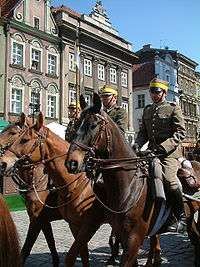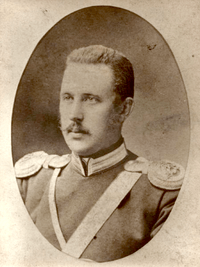3rd Silesian Uhlan Regiment
Third Silesian Uhlan Regiment (Polish language: 3 Pulk Ulanów Slaskich, 3 pul) was a cavalry regiment of the Polish Army in the Second Polish Republic and armoured regiment of the Polish Armed Forces in the West. Its traditions dated back to the 3rd Uhlan Regiment of the Duchy of Warsaw.

Third Uhlan Regiment of the 1st Polish Corps 1917–1918
The Third Uhlan Regiment was formed in November 1917, as part of Polish I Corps in Russia. It existed only until July 1918, and consisted of elements of several other ethnic Polish units.

Third Uhlan Regiment of the Children of Warsaw 1918–1921
On October 13, 1918 in Warsaw, Colonel Stefan Strzemieński began forming a new uhlan regiment. Its squadrons were located both in Warsaw and Zagłębie Dąbrowskie, taking part in disarming of demoralized German soldiers of the Ober Ost. In January 1919, two squadrons were sent to eastern part of former Austrian Galicia, to fight in the Polish–Ukrainian War. In April 1919, whole regiment fought in Polesie and around Minsk, remaining in Belarus until May 1920.
As part of Edward Rydz-Śmigły's Third Army, the regiment fought in Kiev Offensive (1920). It protected Polish rear during the retreat of early summer 1920, and then fought against the Soviets in the bloody Battle of Cycow. In this battle, together with 7th Lublin Uhlan Regiment, it formed 4th Cavalry Brigade. After the battle, the regiment chased the enemy towards Białystok and Augustów, where it clashed with Lithuanian troops, advancing southwards. It then fought in the Battle of the Niemen River, remaining along Polish–Soviet demarcation line until mid-1921.
In the Second Polish Republic
On October 16, 1921, a flag was presented to the regiment, and it was officially named Third Children of Warsaw Uhlan Regiment by the City Council of Warsaw. This name was not accepted by the Ministry of Military Affairs.
In June 1922, the regiment was sent to Polish part of Upper Silesia, to take over the part of the region that was awarded to the Second Polish Republic after the Upper Silesia plebiscite. In the same year, it was garrisoned in the town of Tarnowskie Góry, where it remained until the 1939 Invasion of Poland. In 1924, its reserve squadron was placed in Bochnia, and in 1926, the third squadron was garrisoned in Pszczyna. In 1937–1939, the regiment was part of Kraków Cavalry Brigade (the adjective Silesian was added to its official name in 1938, following the motion of Silesian Sejm).
1939 Invasion of Poland
On September 1, 1939, the regiment, reinforced with National Defense Tarnowskie Góry Battalion was positioned north of Tarnowskie Góry, along the line Kalety – Koszecin. Its third squadron was sent to Boza Gora, where it was engaged in heavy fighting against the advancing Wehrmacht.
Until September 3, the regiment fought German 2nd Light Division. It then began to retreat east, together with whole Army Kraków. On September 6, the regiment took defensive positions near Pińczów, to cross the Vistula two days later. On September 8–12, it fought near Tarnobrzeg, and then retreated further east, to the area of Tarnogród. On September 19, the regiment was destroyed, and on the next day, its remnants capitulated, together with whole Kraków Cavalry Brigade.
Third Home Army Silesian Uhlans Regiment
In mid-1944, the regiment was created by the Home Army (AK). As part of AK's 106th Infantry Division, it operated in the area of Częstochowa and Miechów, to be dissolved on January 19, 1945.
Third Silesian Uhlans Regiment in the West
On August 21, 1944, yet another Third Silesian Uhlans Regiment was formed in San Basilio, Italy, as part of Polish Armed Forces in the West. As an armoured unit, it belonged to the 14th Greater Poland Armoured Brigade. The regiment was dissolved in Great Britain, on June 14, 1947.
Commandants of the Silesian Uhlans 1918–1947
- Colonel Zygmunt Lempicki (14 XI 1917 – 12 II 1918),
- Colone Stefan Strzemieński (12 II – 3 VII 1918 i 13 X 1918 – 16 VII 1920),
- Major Cyprian Bystram (17 VII 1920–1928),
- Colonel Kazimierz Zelislawski (I 1928 – III 1937),
- Colonel Czeslaw Chmielewski (III 1937 – IX 1939)
- Colonel Eugeniusz Swiecicki (1944–1945)
- Colonel Jerzy Anders (1945–1947)
- Home Army Major K. Skierczynski (1943–1945).
Symbols of the Regiment
The regiment had two flags. First one was funded by the Polish diaspora in the USA, and is now kept at the Polish Army Museum in Warsaw. The second one, funded by the residents of Warsaw and presented to the regiment by Józef Piłsudski on October 16, 1921, was lost in the 1939 campaign.
On January 30, 1923, General Kazimierz Sosnkowski accepted the regimental badge. A rectangle-shaped (33 by 30 millimeters), with an oak leaf, and inscription U 3. In the corners of the rectangle were symbolic dates, referring to the history of the regiment: „1807", „1831", „1917" i „1918". The badge was designed by then-commandant of the regiment, Major Cyprian Bystram, and it was manufactured by Warsaw's artisans Mojzesz Nelken and Rubin Krajkemann.
Originally, the regiment celebrated its day on October 16 (the anniversary of the presentation of the new flag). In 1927, the day was changed to September 23, the anniversary of the 1920 capture of the Niemen river bridge near Druskienniki. Finally, in 1937, the day of the 3rd Regiment was established on June 14, the anniversary of the 1919 capture of the town of Lohiszyn (current Belarus).
Third Silesian Uhlans Regiment had its own zurawiejka: "Charging the funeral is the Third Regiment of Uhlans, Each mother sleeps peacefully when her son serves in Bystram's unit, an ass in the saddle, a forehead in the clouds, this is the Tarnowskie Góry regiment".
In April 2007, Public Middle School nr. 4 in Tarnowskie Góry was named after Third Silesian Uhlans Regiment.
Sources
- Jan Przemsza-Zieliński, Księga wrześniowej chwały pułków śląskich, tom I, Krajowa Agencja Wydawnicza, Katowice 1989, ISBN 83-03-02883-9.
- Henryk Smaczny, Księga Kawalerii Polskiej 1914–1947. Rodowody – Barwa – Broń, wyd. TESCO, Warszawa 1989, ISBN 83-00-02555-3.
- Cezary Leżeński, Zostały tylko ślady podków, Książka i Wiedza, Warszawa 1984, ISBN 83-05-11122-9.
- Kazimierz Satora, Opowieści wrześniowych sztandarów, Instytut Wydawniczy PAX, Warszawa 1990